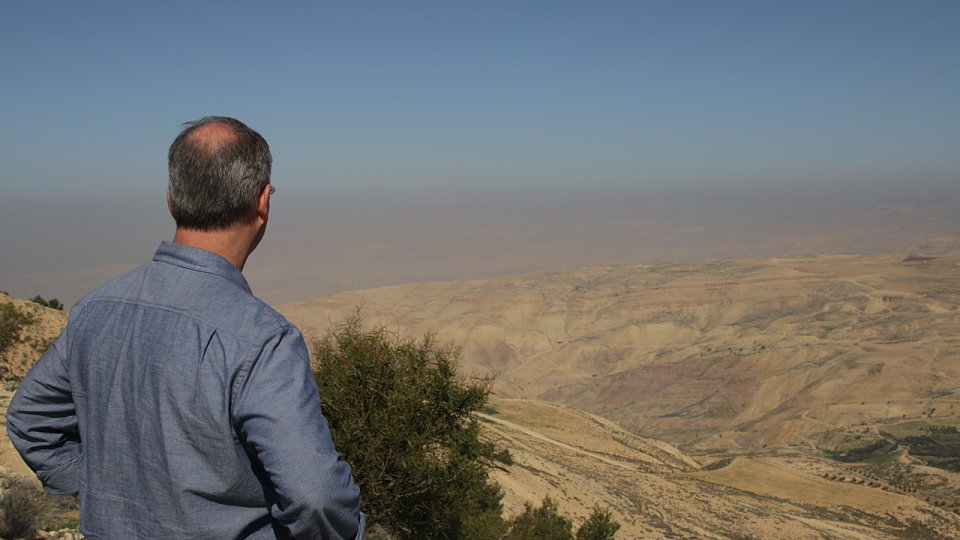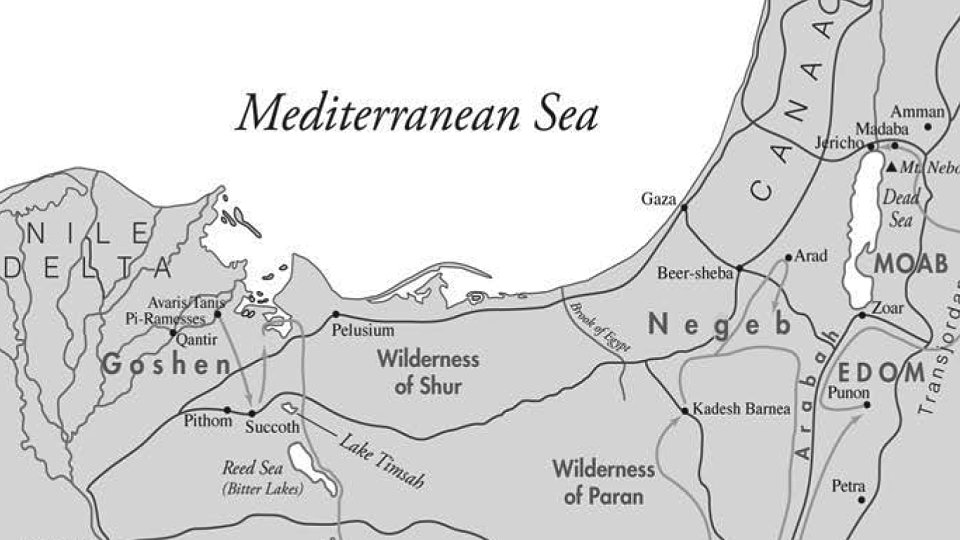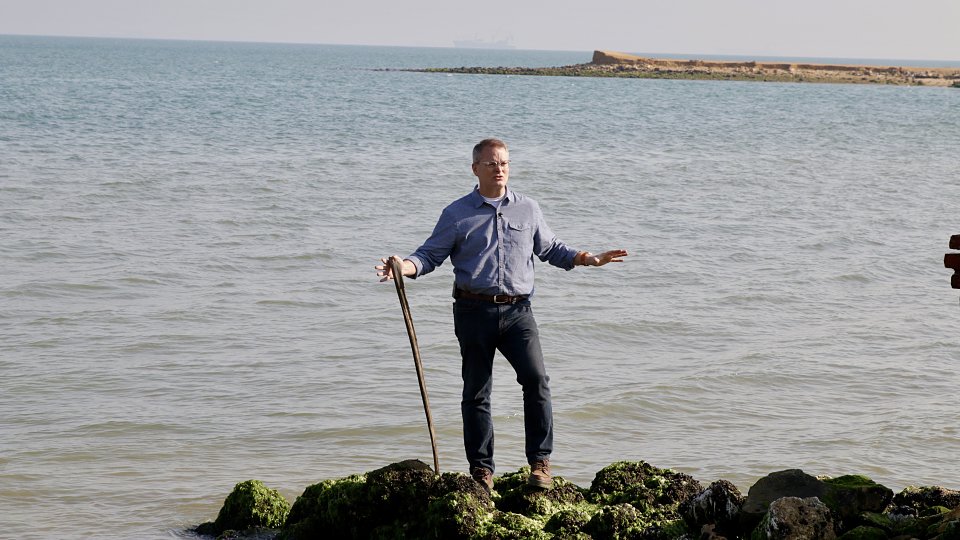Passing on the Faith
Today’s post is an excerpt from Chapter Six of my latest book, Moses: In the Footsteps of the Reluctant Prophet. Click here to read last week’s post, which was taken from Chapter Five. About the photos above: 1) Standing on the top of Mt. Nebo in Jordan, looking over the Promised Land. It was here that Moses stood to catch a glimpse of the Promised Land just before his death. 2) With my granddaughter Stella at the lake. Deuteronomy is set in the final days of Moses’ life. He had led the Israelites to the Jordan River, just east of the Promised Land. God told Moses that he would not actually enter the land with them; shortly he would ascend Mount Nebo, and there he would die. The book is composed of Moses’ farewell discourses—his final words to the Israelites. If there is one theme that stands above the rest in the farewell discourses of Moses that make up the Book of Deuteronomy, it would be Moses’ concern that the Israelites pass on the faith to their children. Thirty-eight verses in Deuteronomy mention children. Many passages are similar to these: These words that I am commanding you today must always be on your minds. Recite them to your children. Talk about them when you are sitting around your house and when you are out and about, when you are lying down and when you are getting up. (Deuteronomy 6:6-7) Why was this admonition important to Moses? So that “you and your children and your children’s children may fear the Lord your God all the days of your life” (6:2 NRSV). Note this same emphasis a few verses later: When your children ask you in time to come, “What is the meaning of the decrees and the statutes and the ordinances that the Lord our God has commanded you?” then you shall say to your children, “We were Pharaoh’s slaves in Egypt, but the Lord brought us out of Egypt with a mighty hand. The Lord displayed before our eyes great and awesome signs and wonders against Egypt, against Pharaoh and all his household. He brought us out from there in order to bring us in, to give us the land that he promised on oath to our ancestors. Then the Lord commanded us to observe all these statutes, to fear the Lord our God, for our lasting good, so as to keep us alive, as is now the case. If we diligently observe this entire commandment before the Lord our God, as he has commanded us, we will be in the right.” (Deuteronomy 6:20-25) There is an urgency to Moses’ words. He knew that Israel’s faith, the faith he had devoted himself to, would be “never more than one generation away from extinction.” Moses’ concern is part of what makes Deuteronomy so timeless. Every generation faces this same challenge. For example, there has been a significant focus in the past few years on the declining religious affiliation among millennials and the overall decline in worship attendance among people of all ages. Some suggest, however, that the sky is not falling. Haydn Shaw, in his book Generational IQ, reminds us that young adults have always dropped out of church in their late teens and returned when they start having children. He notes that millennials are waiting much longer to marry and have children than young people did twenty years ago, which means they are also waiting longer to come back to church. I think he’s right, but that fact alone does not completely explain the decline in religious affiliation and participation that we’re seeing today. I believe that Moses’ words in Deuteronomy continue to be the key to the future of faith. In teaching faith to our children, we don’t want to be guilty of “cramming it down their throats.” But I fear that, for most of us, that’s not the problem. We may take our kids to church and even Sunday school, but we sometimes fail to have meaningful, authentic conversations with them concerning what we really believe about God, how we’ve seen God work in our lives, and what we have experienced of God in prayer and worship—conversations that are not forced but come out of our daily attempts to walk with God. As our children grow up, particularly if they move away from God and the church for a period of time, it becomes harder to have such conversations. During these seasons with my own kids, after they had graduated from high school and had gone away to college, I found it easier to write letters to them conveying my love to them, in which perhaps one paragraph out of seven or eight might be about faith. As a family we continued to pray at mealtime when the girls came home to visit, even if one or the other of them did not bow their heads. I tried to stop preaching and pushing, while at the same time praying and striving to demonstrate something real in my faith that might one day speak to them. Now that I’m a grandfather to a three-year-old granddaughter, I’m wondering if grandparents may be an important key to passing on the faith to future generations. My grandmother Sarah had the greatest impact on my faith when I was a boy. A devout Roman Catholic, she took me to church. Since I was seldom with her on Sunday, she took me to Bingo with the nuns on Friday or to light a candle and walk through the church on a weekday. She taught me to pray the Rosary and was intentional about sharing her faith. It was in reading a Bible she had given our family that I came to faith in Christ. She died when I was thirteen, but I never forgot her faith. Recently I babysat my granddaughter while her parents went out on a “date night.” My wife was out of town, so it was just Stella and Papa. We played together. I let her pick out what we would have for supper: hot dogs, macaroni and cheese, and peas. (Yes, she chose peas!) We ate sitting on the living room floor while watching cartoons together. At one point I took her outside to look at the stars; our home is in the country, so the skies are dark and the stars are bright. I pointed out various constellations and reminded her that her name, Stella, means “star.” We came back inside, had cookies and ice cream, read books, and then, two hours after her official bedtime, I put her to bed (the joy of being a grandparent!). As I lay down with her to put her to sleep, I said to her, “Stella, I want to tell you about something that is really important to Papa.” She looked at me attentively. I asked, “Do you remember the stars?” She nodded. “Do you know that Someone made them all and calls them all by name? That someone is God. He made trees and rabbits and puppies and little girls. We can’t see him, but he’s all around us. And Stella, he loves you. When Mimi and Papa pray, we are talking to him. And do you know what we say to him when we pray? We say thank you.” And with that, Stella and I prayed together. I think that’s what Moses was saying in Deuteronomy. Intentionally sharing and living your faith is crucial so that your children and grandchildren know what you believe and how it shapes your life and so that they see a real and authentic faith in you. Today’s post is an excerpt from Chapter Six, “Don’t Forget … Pass It On,” from my latest book, Moses: In the Footsteps of the Reluctant Prophet. Click here to find more information about all Moses products, including the primary book, a DVD, a Leader Guide, a Children's Leader Guide, and a Youth Study book.




